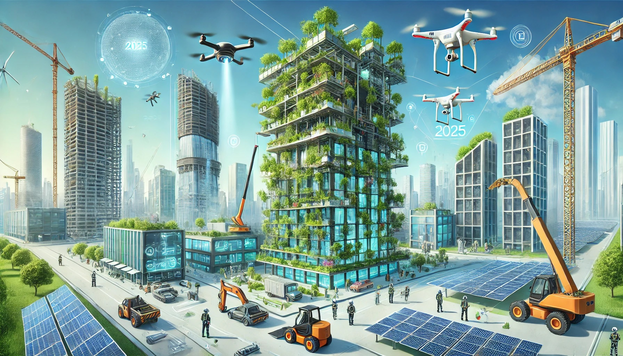
Technology advances are reshaping the construction industry’s approach to turning blueprints into finished buildings. In 2024, 67% of construction firms embraced new technology, a fundamental change from traditional building methods.
Construction companies now face fresh challenges and opportunities, ranging from zero-carbon technologies to automated cost management systems. As the sector advances, building company leaders must adapt to remain competitive.
This piece explores the most important trends shaping modern construction in 2025. It focuses on green practices, cost optimisation, regulatory compliance, and individual-specific experiences. These changes will revolutionise project planning, execution, and delivery methods.
Green Construction Breakthroughs
Sustainability is the lifeblood of modern construction. Construction companies welcome eco-friendly building practices. The sector wants to reduce its environmental footprint, and companies are using green technologies more than ever.
Zero-carbon Building Technologies
Construction accounts for about 30% of global energy sector emissions. Modern companies are using innovative zero-carbon solutions to address this issue. By 2025, all new buildings must meet zero-carbon-ready standards, redefining cleaner practices’ limits. Buildings now use materials like low-carbon concrete, bamboo, and cross-laminated timber.
Key environmental benefits of zero-carbon buildings:
- 75-80% lower carbon emissions compared to current levels
- 31% reduction in CO2 emissions from 2021
- Increased building longevity and lower maintenance costs
Renewable Energy Integration
Intelligent building systems have transformed energy management in construction. Buildings can now produce as much energy as they use. Building companies combine solar panels, wind turbines, and advanced insulation materials to maximise energy efficiency.
Waste Reduction Strategies
UK’s construction industry produces more than 60% of the country’s waste, and 32% ends up in landfills. Construction companies tackle this challenge through:
- Modular construction techniques that minimise waste
- Cloud-based construction platforms for resource optimisation
- AI-driven forecasting for improved material usage
The circular economy idea has gained ground by promoting material reuse and recycling. Construction teams build structures with longer lifecycles and lower carbon footprints. This approach works well, with over 455 million tons of construction debris moving to the subsequent use.
Cost-effective Construction Solutions
Financial efficiency propels modern construction forward. The construction management software market, projected to reach USD 4767.70 million by 2032, shows the industry’s move toward digital solutions.
Automated Cost Management Systems
Leading construction companies now welcome cloud-based cost management platforms. These systems provide live visibility of cost-related risks and improve forecast accuracy. Companies that use these tools experience 52% fewer non-recoverable change orders and handle 48% more construction volume per employee.
Resource Optimization Tools
Digital platforms reshape resource allocation in construction. Key benefits include:
- 62% faster processing time
- 93% improvement in contract processing
- 30% revenue growth without staff increases
Building companies exploit these tools to monitor labour hours, equipment usage, and material inventory. The systems prevent delays and minimise waste through evidence-based decision-making.
Budget Planning Technologies
Modern budget planning software reshapes financial control in construction. The volatile market faces affected by supply chain disruptions and fuel price impacts. Construction firms need more innovative solutions, so they now use predictive analytics to examine historical cost data, material prices, and labour costs.
These technologies help construction teams to:
- Monitor expenses live
- Generate automated forecasts
- Adjust based on actual spending
Accounting and operations integration eliminates manual data entry and reduces liability risks. Project owners and general contractors focus on cash flow management to protect profits from interest and risk erosion.
Regulatory Compliance and Standards
Rules and regulations are the foundations of today’s construction practices. Construction companies must deal with complex requirements in 2024-2025. Digital solutions have become tools they can’t do without.
Digital Compliance Tools
Construction firms now use specialised software to manage regulations. These digital platforms reduce compliance paperwork by 70% and simplify documentation-building companies, which depend on these tools to keep accurate records and handle compliance tasks automatically. The software Givalso provides monitoring features and simplifies oversight
Key compliance management features include:
- Electronic submission of safety records
- Automated deadline tracking
- Centralised document storage
- Mobile-responsive interfaces
Environmental Regulations Impact
Environmental standards constantly reshape construction practices. The EPA has set strict limits for contaminants at 4 parts per trillion. Public water systems must meet these standards by 2029. Construction projects now require complete environmental impact assessments and regular checks.
Safety Standard Updates
OSHA’s new rules require companies to submit injury and illness data in January 2024 electronically. Companies with over 100 employees must also send detailed safety records every year. This open approach aims to reduce workplace incidents and create safer construction sites.
The Department of Labor’s updated Personal Protective Equipment standards are now in effect. These changes look at proper fitting requirements for all workers and focus on:
- Women in Construction
- Physically smaller workers
- Specialised equipment needs
Digital safety management systems help track these requirements and reduce paperwork by 70%. Construction firms see better compliance rates and faster processing times with automated systems.
Client Experience Enhancement
Digital technology is reshaping how construction companies connect with their clients. They now use advanced technologies to deliver exceptional project experiences and clear communication.
3D Visualization Tools
Modern 3D visualisation tools allow clients to see their projects before construction begins. These tools create interactive models that help review designs quickly. Building companies use these platforms to show real-time walkthroughs and adjust designs based on client priorities.
Key benefits of 3D visualisation include:
- Better teamwork between groups
- Increased efficiency in design reviews
- Significant cost savings compared to physical prototypes
- Swift design changes based on feedback
Progress Tracking Platforms
Intelligent tracking systems are changing how projects are managed. Modern companies use AI-powered platforms that track more than 80 pages of construction. These systems cut manual tracking time by 95% and speed up schedules by 11%.
Progress tracking technology captures detailed data through 360° photo documentation. Clients can check immediate updates and see construction progress from any location. The platforms create automatic quantity surveys and compare designs to actual work within 48 hours.
Communication Systems
Digital communication tools make project coordination and client interactions smoother. Modern platforms create central hubs where everyone shares updates and project changes immediately. These systems cut costs by spotting inefficiencies early and better planning material deliveries.
Construction teams use cloud-based tools to share information instantly. These platforms offer mobile access to project details, which speeds up decisions and keeps communication flowing. Digital tools have shown 62% faster processing times and better project results through more intelligent data handling.
Conclusion
Digital breakthroughs, eco-friendly practices, and innovative cost management have revolutionised modern construction. Companies that accept new ideas show remarkable improvements – from 75% lower carbon emissions to 62% faster project processing times.
Digital tools facilitate regulatory compliance and improve client communication. Construction teams can now build faster, safer projects with greater precision. 3D visualisation and AI-powered progress tracking have made construction more transparent. Thus, the quickest way to complete projects now exists.
Construction’s future looks promising. Companies will lead the industry by combining eco-friendly building practices with digital cost management and advanced client communication tools. Technology continues to reshape our building methods, and the next few years will bring more exciting breakthroughs.




 POSTED BY
POSTED BY 

